Please report any broken links or trouble you might come across to the Webmaster.
Please take a moment to let us know so that we can correct any problems and make your visit as enjoyable and as informative as possible.
| Click On Image For Full Size | Size | Image Description | Source | |
|---|---|---|---|---|
 |
46k | Commemorative post mark on the occasion of the keel laying of the Mackerel (SS-204), 6 October 1939 at the Electric Boat Co., Groton, CT. | Photo courtesy of Scott Koen & ussnewyork.com. | |
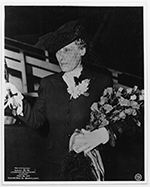 |
348k | Mackerel (SS-204) was sponsored by Mrs. W. R. Furlong, wife of Admiral William Rea Furlong, who served as the Chief of Naval Ordnance from 1937 to 1941. | Photo courtesy of Dale Hargrave. Text courtesy of wikipedia |
|
 |
22k | Commemorative post mark on the occasion of the launching of the Mackerel (SS-204), 28 September 1940 at the Electric Boat Co., Groton, CT. | Courtesy of Jack Treutle (of blessed memory). | |
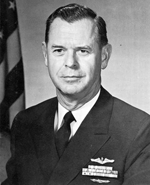 |
208k | Lt. John F. Davison was the Mackerel's (SS-204) first commanding officer from 1941 to 1942. He went on to win the Silver Star while in command of the Blackfish (SS-221) from October 1942 to December 1943. He became Superintendent of the U.S. Naval Academy during the Kennedy administration from 1960 to 1962. | Photo & text courtesy of David Johnston. | |
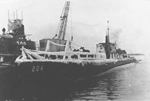 | 1.03k | Grayback (SS-208) fitting out & Mackerel (SS-204) with ice on her fore deck and radio wires, photographed in early 1941. | Photo courtesy of Scott Koen & ussnewyork.com. | |
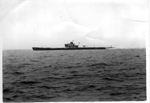 |
344k | Mackerel (SS-204) photographed in early 1941 during sea trials. She has ice on her fore deck and radio wires. | Text i.d. courtesy of Ric Hedman. Photo # EB 7414 courtesy of LT Howard G. Havens collection at the Vallejo Naval and Historical Museum via Darryl L. Baker. |
|
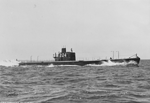 |
500k | Mackerel (SS-204) making 16.0 knots while running trials, 22 March 1941. | USN photo # 19-N-23871 from the Bureau of Ships Collection in the U.S. National Archives via Robert Hurst. | |
 |
140k | Mackerel (SS-204), port bow view, while running trials, 22 March 1941. | USN photo # 19-N-23722 from the Bureau of Ships Collection in the U.S. National Archives. | |
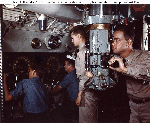 |
103k | Submarine Commanding Officer sights through a periscope in the submarine's control room, during training exercises at the Submarine Base, New London, Groton, Connecticut, in August 1943. In the background, another officer watches men at the control dials.
Photographed by a member of Edward Steichen's unit. Note: Captain Edward L. Beach commented (during the mid-1980s) that this submarine is not a "Fleet Boat", but is more likely either Mackerel (SS-204) or Marlin (SS-205). He also thought that the officer at the periscope might be John F. Walling, who was lost in April 1945 while commanding Snook (SS-279). |
USN photo # 19-N-23871 from the Bureau of Ships Collection in the U.S. National Archives. B&W high res here USN photo # 80-G-43492 by Cdr. Edward J. Steichen, from National Archives and Records Administration (NARA), College Park, Maryland, courtesy of Sean Hert. |
|
 |
430k | Commemorative post mark on the occasion of Mackerel's (SS-204) first day in commission, 31 March 1941. | Courtesy of Jack Treutle & Tommy Trammp. | |
 | 20k | Commemorative postal cover marking Navy Day, 27 October 1941 and the following submarines commissioned since the previous year: Trout (SS-202), Tuna (SS-203), Mackerel (SS-204), Marlin (SS-205), Gar (SS-206), Grampus (SS-207), Grayback (SS-208), Grayling (SS-209), Grenadier (SS-210) & Gudgeon(SS-211). | Courtesy of Jack Treutle (of blessed memory). | |
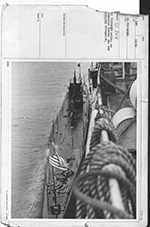 |
975k | Pocomoke (AV-9) acting as a submarine tender for the Mackerel (SS-204) alongside, December, 1941. | USN photo # 80CF-137, from National Archives and Records Administration (NARA), College Park, Maryland, courtesy of Sean Hert. | |
 |
78k | Mackerel (SS-204) shows her war modifications in this 16 December 1942 photograph: an SJ radar forward of her two periscopes: an SD abaft them; and a 20-mm gun abaft her bridge fairwater. Note the paired radio antennas extending to her bridge. | USN photo. Text courtesy of U.S. Submarines Through 1945, An Illustrated Design History by Norman Friedman. Naval Institute Press. | |
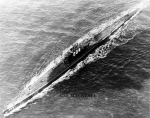 |
107k | Mackerel (SS-204), port side view, circa 1940's, most likely underway in the Atlantic Ocean off New London, CT. | USN photo courtesy of ussubvetsofworldwarii.org. | |
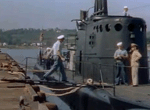 |
581k | Still photo from the 20th Century Fox 1943 production of Crash Dive starring Tyrone Power and Dana Andrews. This photo shows one of the two boats used during filming of the movie, the Mackerel (SS-204). The outdoor scenes of the movie were filmed during the late summer of 1942 entirely at the Naval Submarine Base New London, CT. Notice Mackerel's overall visual simularity to the fleet boats, even though being considerably smaller. As built, Mackerel's periscope shears were covered in steel plate. This has been removed by the date of this photo, in an attempt to reduce the boat's visual silhouette. Other than this simple expedient, Mackerel's silhouette remained largely unchanged for the rest of her career. Unlike her fleet boat cousins, she was built with the conning tower fairwater cut down aft of the bridge and periscope shears, providing an anti-aircraft gun deck surrounded by an open railing (just visible in this photo). The gun originally installed there was a water-cooled M2 .50 caliber machine gun. | Photo & text courtesy of David Johnston. | |
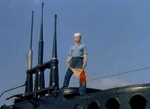 |
118k | A close up shot (late summer 1942) of the Mackerel's periscope shears, a still from the movie Crash Dive. Both of the Mackerel's scope let into the control room. Her conning tower was very small, not much more than an access trunk to the bridge. The mast aft of the scopes is an communication antenna. This would be replaced by an SD air-search radar mast in December 1942, and an SJ surface search antenna would be added forward of the scopes. | Photo & text courtesy of David Johnston. | |
 |
120k | E.B.'s Mackerel (SS-204) is shown in December 1942. The bridge fairwater was never rebuilt. The periscope shears have been cut away, & a 20-mm gun mounted abaft the bridge. Aft was a 3-in/50 gun. Plans originally called for a 0.50-caliber gun in the bridge position, with another atop the bridge itself. Radars (SJ forward, SD aft) were added. Unlike a contemporary fleet boat, she had direct drive diesels (the axillary generator was mounted just forward of the starboard engine), & she had no separate maneuvering room or control cubicle (these controls were in the main crew berthing area). The conning tower was a short cylinder, little more than a trunk between control room & bridge. The objects inside the bridge fairwater, from forward to aft, were the main induction (and the boat's exhaust valve) the boats air supply valve, and the battery exhaust valve, the first two are big mushrooms. This drawing does not show Mackerel's sonar, originally a JK (probably QB/JK by 1942) that could be lowered from a keel trunk just abaft the well for the antenna (SD) mast. Although complement was listed as 4 officers & 38 enlisted men, the plans show only 32 enlisted & 4 petty officer berths: 10 enlisted berths in the forward torpedo room, 20 in the crew quarters abaft the control room & galley, & 2 adjacent to officer's berths. The plans do not show any berths in the after torpedo room. The petty officers were accommodated just forward of the officer's berth. |
Drawing courtesy of Jim Christley. Text courtesy of U.S. Submarines Through 1945, An Illustrated Design History by Norman Friedman. Naval Institute Press. |
|
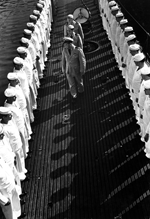 |
725k | Mackerel's (SS-204) crew line the boat's deck during an inspection at New London submarine base, Conn. August 1943. Regarding the crew, one thing noticeable is that none of them are wearing the Combat Pin. Although it does not appear to be a formal inspection, ie, crew is in ‘undress' whites, the officers, although in dress khakis, might not have worn the Combat Pin, but with ribbons displayed. The ‘command pin' on the leading officer is also not present. One of the differences between the Mackerel & the Marlin (SS-205) is the Marker buoy directly aft of the hatch. On Marlin it is forward to port. Regarding the lack of combat pins by the crew in this photo; the Mackerel was a training boat the entire war. | NARA FILE #: 080-G-468153, photographed by Comdr. Edward J. Steichen. Photo # HD-SN-99-02606, courtesy of dodmedia.osd.mil, Defense Visual Information Center. Photo I.d. & text courtesy of Jim Christley, David Decrevel, John Hart, John Hummel, David Johnston (USN, retired) & Ron Reeves (of blessed memory) | |
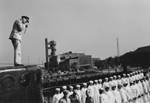 |
581k | Cdr. Edward J. Steichen gets an angle for his photo op during an inspection for Mackerel's (SS-204) crew. Photographed at the Submarine Base, New London, Conn. Photo released 4 November 1943. |
USN photo # 80-G-43487 by Cdr. Edward J. Steichen, from National Archives and Records Administration (NARA), College Park, Maryland, courtesy of Sean Hert. | |
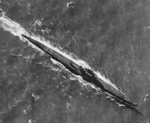 |
686k | Mackerel (SS-204) rides the waves. | USN photo # 80G-419708, from National Archives and Records Administration (NARA), College Park, Maryland, courtesy of Sean Hert. | |
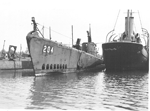 | 446k | Mackerel (SS-204) & Cachalot (SS-170) lie in wait before their final tow for scrapping on 24 April 1947, to North American Smelting Co., Philadelphia, PA. They are somewhere on the Delaware River on the New Jersey side. Note the raised drawbridge in the background (just to the left of Mackerel's conning tower), most likely a railroad bridge. The Cachalot is inboard, probably resting on a bank of one of the many creeks. Partially stripped. Her name in raised letters can clearly be seen. Mackerel looks rigged for a tow. The black hull yacht like vessel outboard of Mackerel is a mystery. There is some fancy scroll work on her port quarter. | Photo & partial text courtesy of Jim Swank. | |
| Back To The Main Photo Index | Back To the Submarine Index |
|
Problems and site related matters, E-mail Webmaster |
|
This page is created by Gary Priolo, and maintained by Michael Mohl All Pages © 1996 - 2024 NavSource History All rights reserved. |